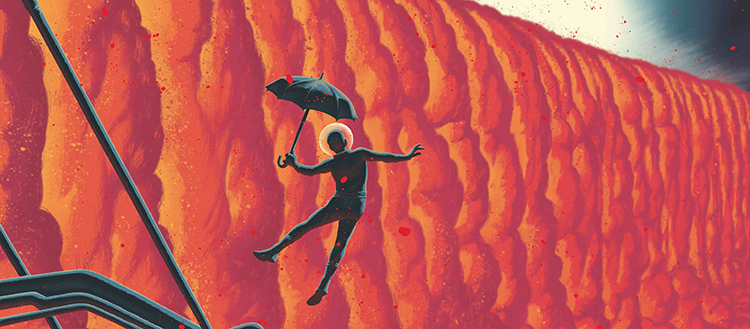Iron rain in the evening on a giant exoplanet
An international team of astronomers, led by UNIGE, has discovered a planet where it rains iron.
Work by the Geneva cartoonist Frederik Peeters: «Singing in the Iron Rain: An Evening on WASP-76b». (Detail - © Frederik Peeters)
Thanks to a new instrument conceived by the University of Geneva (UNIGE), Switzerland, and set at the Very Large Telescope (VLT) of the European Southern Observatory (ESO), an international team of researchers, led by UNIGE, has observed a planet featuring iron rains. This giant exoplanet has an ultra-hot day side with temperatures rising above 2,400°C, high enough to vaporise metals. Strong winds then carry the iron vapour to the 1,000-degree-cooler night side where it condenses into iron droplets. The study is published in Nature.
WASP-76b is an exotic planet some 390 light years away in the constellation Pisces. “One could say this planet gets rainy in the evening, except that it rains iron”, says David Ehrenreich, a professor in the Department of Astronomy in the Faculty of Science at UNIGE and the first author of the study.
A double-sided planet
This strange phenomenon occurs because the planet constantly shows only one side, the day side, to its parent star, leaving its colder night side in perpetual darkness. Like the Moon in its orbit around the Earth, WASP-76b is “tidally-locked”: it takes the planet as long to rotate around its axis as it does to go around its star.
On the day side, WASP-76b receives thousands of times more radiation from its parent star than the Earth receives from the Sun, raising its temperature to over 2,400°C. It is so hot that molecules split into atoms and metals, such as iron, evaporate into the atmosphere. The extreme temperature difference between day and night then results in vigorous winds that carry iron vapour from the ultra-hot day side to the cooler night side, where temperatures drop to about 1,500°C.
Chemical variations causing iron rains
Not only does WASP-76b have an extreme temperature difference between day and night, it also has a distinct day-night chemistry. Using the new ESPRESSO instrument on the ESO VLT in the Chilean Atacama Desert, astronomers have identified for the first time the chemical variations on an ultra-hot gas giant planet. They detected a strong iron vapour signature at the evening frontier, where the planet moves from its day to its night side. “Surprisingly, however, we don’t see iron vapour on the other side of the planet, in the morning, says Christophe Lovis, a researcher at UNIGE and lead-data analyst of ESPRESSO. The conclusion is that the iron has condensed during the night. In other words, it rains iron on the night side of this extreme exoplanet.”
This result was obtained thanks to the very first scientific observations made with ESPRESSO, in September 2018.
ESPRESSO – the Echelle Spectrograph for Rocky Exoplanets and Stable Spectroscopic Observations – was built by the Department of astronomy of UNIGE with an international consortium composed of teams in Portugal, Italy, Switzerland, Spain and ESO. Originally designed to hunt Earth-like planets around Sun-like stars, it has proven to be much more versatile. “We thought very early on that we could use the instrument not only to discover new planets, but also to characterize those that are already known. However, until 2018, we didn’t realise how powerful ESPRESSO really was in this field”, explains Francesco Pepe, professor at the Department of astronomy of the Faculty of Science at UNIGE and principal investigator of the ESPRESSO consortium. “Thanks to this technology, we now have a completely new way of tracing the climate of the most extreme exoplanets”, concludes David Ehrenreich.
11 Mar 2020
